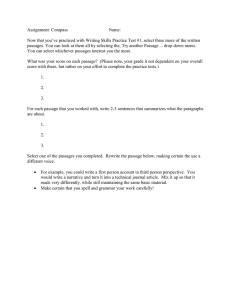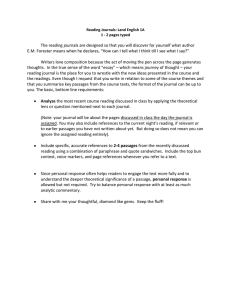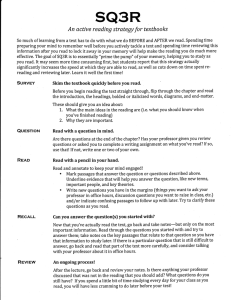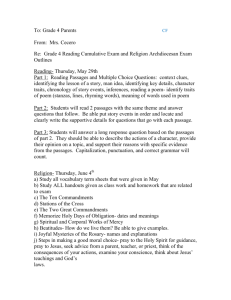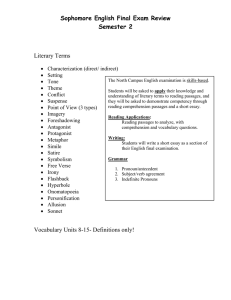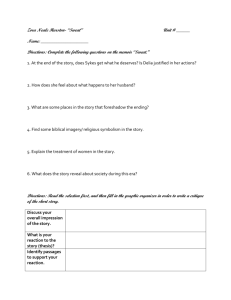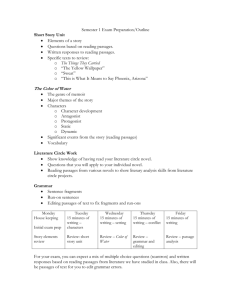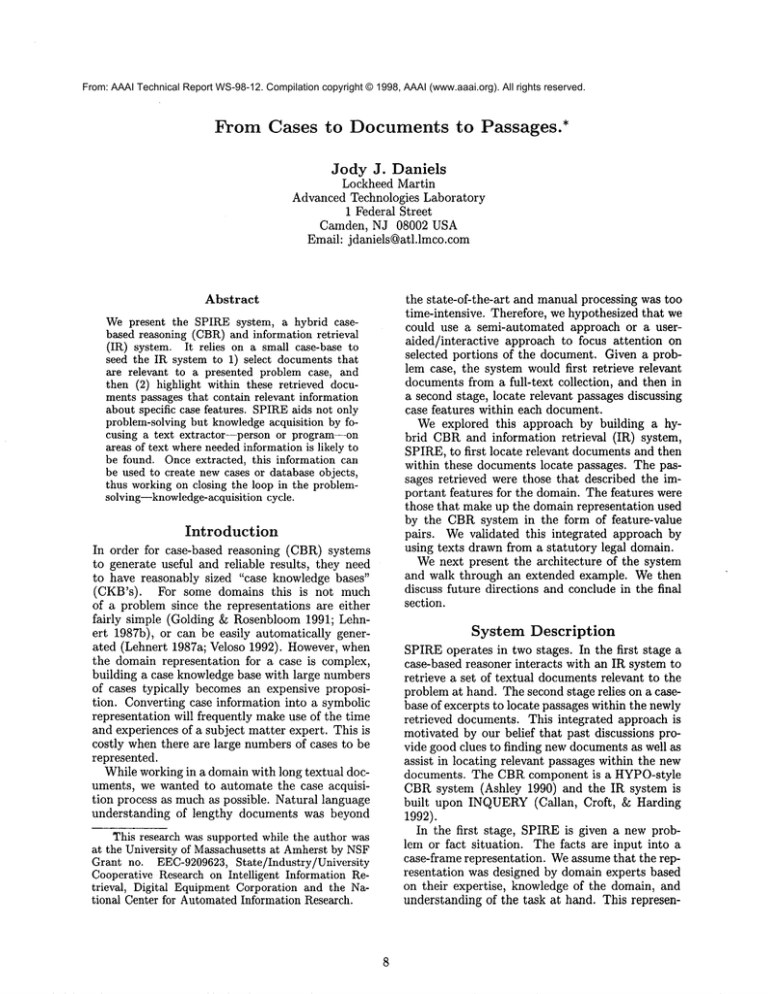
From: AAAI Technical Report WS-98-12. Compilation copyright © 1998, AAAI (www.aaai.org). All rights reserved.
From Cases
to
Documents
to
Passages.*
Jody J. Daniels
Lockheed Martin
Advanced Technologies Laboratory
1 Federal Street
Camden, NJ 08002 USA
Emaih j daniels@atl.lmco.com
Abstract
Wepresent the SPIRE system, a hybrid casebased reasoning (CBR)and information retrieval
(IR) system. It relies on a small case-base
seed the IR system to 1) select documentsthat
are relevant to a presented problem case, and
then (2) highlight within these retrieved documents passages that contain relevant information
about specific case features. SPIREaids not only
problem-solving but knowledgeacquisition by focusing a text extractor--person or program--on
areas of text whereneededinformation is likely to
be found. Onceextracted, this information can
be used to create new cases or database objects,
thus workingon closing the loop in the problemsolving--knowledge-acquisitioncycle.
Introduction
In order for case-based reasoning (CBR) systems
to generate useful and reliable results, they need
to have reasonably sized "case knowledge bases"
(CKB’s). For some domains this is not much
of a problem since the representations are either
fairly simple (Golding & Rosenbloom 1991; Lehnert 1987b), or can be easily automatically generated (Lehnert 1987a; Veloso 1992). However, when
the domain representation for a case is complex,
building a case knowledge base with large numbers
of cases typically becomes an expensive proposition. Converting case information into a symbolic
representation will frequently makeuse of the time
and experiences of a subject matter expert. This is
costly when there are large numbers of cases to be
represented.
While working in a domain with long textual documents, we wanted to automate the case acquisition process as muchas possible. Natural language
understanding of lengthy documents was beyond
This research was supported while the author was
at the University of Massachusetts at Amherstby NSF
Grant no. EEC-9209623,State/Industry/University
Cooperative Research on Intelligent Information Retrieval, Digital EquipmentCorporation and the National Center for AutomatedInformation Research.
the state-of-the-art
and manual processing was too
time-intensive. Therefore, we hypothesized that we
could use a semi-automated approach or a useraided/interactive
approach to focus attention on
selected portions of the document. Given a problem case, the system would first retrieve relevant
documents from a full-text collection, and then in
a second stage, locate relevant passages discussing
case features within each document.
We explored this approach by building a hybrid CBRand information retrieval (IR) system,
SPIRE,to first locate relevant documents and then
within these documents locate passages. The passages retrieved were those that described the important features for the domain. The features were
those that make up the domain representation used
by the CBRsystem in the form of feature-value
pairs. Wevalidated this integrated approach by
using texts drawn from a statutory legal domain.
Wenext present the architecture of the system
and walk through an extended example. We then
discuss future directions and conclude in the final
section.
System Description
SPIREoperates in two stages. In the first stage a
case-based reasoner interacts with an IR system to
retrieve a set of textual documentsrelevant to the
problem at hand. The second stage relies on a casebase of excerpts to locate passages within the newly
retrieved documents. This integrated approach is
motivated by our belief that past discussions provide good clues to finding new documentsas well as
assist in locating relevant passages within the new
documents. The CBRcomponent is a HYPO-style
CBRsystem (Ashley 1990) and the IR system
built upon INQUERY(Callan, Croft, & Harding
1992).
In the first stage, SPIREis given a new problem or fact situation. The facts are input into a
case-frame representation. Weassume that the representation was designed by domain experts based
on their expertise, knowledge of the domain, and
understanding of the task at hand. This represen-
tation is exploited by the case-based reasoner to
perform the desired type of reasoning.
SPIRE uses its CBRmodule to analyze the situation and select a small number of most relevant
cases. These cases come from the reasoner’s CKB.
In standard CBRfashion, SPIRE determines the
similarity of each knowncase to the new problem,
sorts the relevant knowncases according to their
degree of on-pointness, and represents the results
of this analysis in a standard claim lattice.
The most relevant cases from this analysis-typically the cases in the top two layers of the claim
lattice--are
then used to "jump-start" INQUERY’s
relevance feedback module. This set of "best" cases
is called the relevance feedback case-knowledge-base
or RF-CKB.The original text of the cases in the
RF-CKB(i.e., the opinions) are passed to the
engine. The IR engine then treats these documents
as though they had been marked relevant by a user.
Using a modified form of relevance feedback, (we
start with an empty query and generate one, rather
than modify or expand an existing query,) the IR
system generates a query by selecting and weighting
terms or pairs of terms from within the RF-CKB.
This query is then run against the larger corpus of
texts, with the result that documents (court opinions) are retrieved and ranked. Figure 1 gives an
overview of this process. (Moredetails on this process can be found in (Daniels & Rissland 1995).)
Figure 1: SPIRE’s retrieval process for novel documents.
In the second stage, SPIRElocates germane passages within each of the texts retrieved in stage
one. There is no real limit on how many of the
texts can be examined in stage two, however, we
generally examined only the top ten. If we were
able to set a threshold that would distinguish between texts that were relevant and those that were
not, we would process additional documents until
that threshold was reached.
To now locate the text segments that discuss a
particular feature, SPIRE once again uses a hybrid CBR-IR approach but this time the task is
to locate passages (within a document) rather than
documents (within a collection). To locate these
passages, SPIREgenerates queries that express the
information need associated with the particular feature. To do this, SPIREuses information from past
discussions of a feature.
For each case feature of interest, SPIRE has a
case-base of textual excerpts, called the excerptckb. Each piece of text in the excerpt-ckb comes
from an episode of information location/extraction
performed on a past case. Using the excerpt-ckb
SPIREgenerates a feature-level query to be run on
each document. Figure 2 gives an overview of the
passage retrieval process.
. .....................
~
¯
1
III I
tU I
Casete""~ts
Excerpts
\ Features
I,-,~.M
I~’1
¯
Information Retrieval
System
New
Texts
Excerots
~
I Additional
I Excerpts
I NewCases
User/----.~l"...........
IE System L
k I Query I
¯ |Gefieraiionl Passage
J~.e~I
IL...........
’,
I
II
j
i
i.~-r-~
~ .......
[ P ..... |
I R~fie~al
I
. Top
Figure 2: SPIRE’s passage retrieval
J
_eas..sages
........
.
subsystem.
SPIRE presents the passage query along with a
specified document to the IR engine, which divides
the document into overlapping windowsof 20 words
each, approximating the length of a sentence. Each
word in the opinion will appear in two windows(except for the first 10 words). The IR engine then retrieves the top-ranked passages for presentation to
the user (or possibly to an information extraction
system). (More details on this process and experimental results can be found in (Daniels 1997).)
Thus, the excerpts are used analogously to the
RF-CKB’sof stage one: their terms are used to
to generate queries. The difference is that (at this
point in our development of SPIRE) there is no
selection of excerpts according to some model of
relevance since all are used to generate the query.
At some point, when these excerpt collections becomelarger, the question of winnowingor selecting
excerpts will becomean interesting one.
Wecreated these case-bases of excerpts by asking
an individual familiar with the representation of the
problem domain to highlight example excerpts in
the opinions corresponding to a small number of
the cases in SPIRE’scase-base. 1 Typically this will
only be a few documents, on the order of 10-15.
In summary, given a new problem or topic,
SPIREretrieves documents from a text collection
in its first stage. It highlights passages relevant
to knowledge about specific features from each of
these documents in its second stage. The user
1This step would normally be done in conjunction
with the creation of the representation for the domain
and the encodingof the first few cases; thus eliminating
the needfor a full reviewof the texts.
may decide to add one or more of the retrieved
passages, or selected portions of them, to the appropriate excerpt-ckb along with the feature and
value. These new excerpts may be used to form
later passage queries. This way, SPIREmay aid in
the acquisition of additional knowledge about the
context of each feature. Once the new texts have
been converted and added to the CKB, the CBR
component may reason about them relative to the
current problem or fact situation and the original
task.
Example
For this example, we allow SPIREto use a simple
method to generate queries: it combines the terms
from all the excerpts about a feature into a single
"natural language" query. Each word in each excerpt provides a possible match against the words
in the window. Regardless of whether two words
were in different excerpts, each contributes to the
total belief. Part of this query for duration is shown
below:
#Passage20(
just over 25 monthly payments
the plan would pay out in less than 36 months
proposed a three-year plan for repayment .... )
Posing the query over the Sellers opinion causes
the retrieval of manyrelevant passages. Beloware
the top five passages for it annotated with whether
or not each is relevant:
Bag of Words
Rank Psg Strt Belief
1
1430
(0.404378) REL
2
1440
(0.404199) REL
2650
3
(0.402939) REL
4
2660
(0.402002) REL
1420
5
(0.401956) REL
Figure 3 gives the text of the 1430 and 1440 passages, the top two passages. (We have included
the text from the passage beginning at 1420 as it
is ranked fifth.) Weboldface content terms that
match those found in the excerpt-ckb and show
word counts along with the text.
From either the 1430 or the 1440 passage we can
determine that the debtor proposed a 36-month
plan. From the 1440 passage we can also learn that
24 payments had already been paid at the time of
the hearing.
The third ranked passage is 2650, displayed in
Figure 4. (We include enough text to cover passage
2660, as it ranked fourth.) These passages address
the duration of a repayment plan in a related case
that the judge is summarizing.
In stage two, SPIRE has located passages in
an individual document relevant to the duration
feature without requiring a user to pose a query.
SPIREcan do this for any feature for which there
is an excerpt-ckb, and on any individual document.
To better illustrate the approach we used in SPIRE,
we run through the following scenario based on a
case from Chapter 13 of United States personal
bankruptcy law (11 U.S.C. §1301-1330). In this
case the debtors proposed a plan to discharge a
large debt that had been fraudulently obtained.
The debtors had recently used a different section
of the bankruptcy code to discharge other debts.
We submit the case to SPIRE, which compares
it to those situations found in its own case-base.
By examining the text opinions of the most related
cases, SPIRE forms a query that it passes to the
IR engine, which in turn retrieves what it believes
are the most relevant case opinions.
The next step is to examinethese newly retrieved
case opinions for specific facts, in particular, the
length of other debt repayment plans. To do this,
we direct SPIREto locate passages within the top
opinions that concern the feature called duration.
SPIREuses its excerpt-ckb on duration to form a
query to retrieve passages. Below are sample excerpts from the duration excerpt-ckb:
¯
¯
¯
¯
"just over 25 monthly payments"
"the plan wouldpay out in less than 36 months."
"proposed a three-year plan for repayment,"
"The Court wouldrequire the Ali’s [sic] to pay $89
per month for 36 months."
¯ "Debtors propose paymentsof $25.00 weekly for 3337 months."
¯ "wouldbe paid in full after twoyears. In the four or
five monthsfollowing this two-year period, the unsecured creditors would be paid the proposed amount
of 10%of their claims."
Discussion
This approach, as executed by SPIRE, locates relevant documents and then passages, but these passages are consecutive windowsand are not based on
thematic or discourse units. This methodis fine for
indexing and retrieval, but presentation to a user
may be confusing. Additionally, we have yet to take
advantage of information based on the structure of
the excerpt during retrieval, nor have we incorporated any domain-specific knowledge into the process. Webriefly discuss three approaches to refining the query formulation process that would help
The top-rated newly retrieved document for this
problem case is the Sellers 2 case opinion, so we
use it to illustrate
SPIRE’s second stage. The IR
engine divides the Sellers opinion into overlapping
windows of 20 words each. SPIREthen generates a
query to be run against the Sellers opinion, divided
into these windows. The IR engine carries this out
and ranks the passages according to its belief that
each is relevant to the query.
2In re Sellers, 33 B.R. 854, 857 (Bankr. D. Colo.
1983)
10
¯ .. spirit
and purpose of Chapter 13. The debtor’s proposed AmendedPlan
called for payments of $260.00 per month for a period
of 36 months. Pursuant to [the] Court Order, the debtor has
made 24 monthly payments without a default¯ Of course, at
the time of the original hearing...
1420
1430
1440
1450
Figure 3: Passages 1420, 1430, and 1440.
2650
2660
2670
¯.. The debtor’s plan
is scheduled to run for only fifteen monthsinstead of
the more commonperiod of three years. This proposal to
pay for only a limited time seems to relate with
particulm’ity to repayingonly...
Figure 4: Passages 2650 and 2660.
enhance retrieval accuracy while minimizing user
effort: query expansion, learning, and concept recognizers.
Wehave not yet learned when it is appropriate
to add new excerpts to the case-base. Our results
have shown the need to keep information about
terms that appear multiple times in the excerptckb (Daniels 1997). However, we need to be careful
that we do not add too many copies of closely related excerpts such that some terms dominate and
overwhelm the retrievals.
Wewant to ensure that
we have coverage of the most typical means of expressing the feature, yet allow for the retrieval of
possible exceptions.
Query expansion
We currently only use information gleaned from
the excerpts to form our queries. We have not
yet explored taking advantage of information found
across the entire collection of documents to find
terms related to those in the excerpts.
One possible technique is to apply query expansion. Wecould use a thesaurus to add new terms.
Alternatively, we could further refine our expansion
operation to take advantage of domain knowledge
by building an association thesaurus (Jing & Croft
1994). Wehave several available databases from
which we could build our association thesaurus: the
entire collection, or just those documents related
to the problem case as found in the CKB.Another
possibility would be to build the thesaurus from
an intermediate collection, such as that comprised
of the documents retrieved by SPIRE with the
document-level query. Thesauri built from the second and third collections would be highly domainand problem-specific.
Concept
recognizers
Pattern matching techniques that can rely on regular expressions or an inclusive listing of the set
memberscould be quite beneficial for some of the
features. For instance, if we were to use a concept
recognizer that assigned credit to passages containing a date, rather than giving credit for each individual term, retrievals wouldlikely benefit because
of fewer spurious matches.
Concept recognizers that might prove useful are
monetary amounts, dates, and time periods. Specific dollar amounts are present in many of our
features and actual values are frequently in the
text. Example features with monetary amounts
are monthly payments (toward either a bankruptcy
plan or a loan), monthly income, monthly expenses,
amount of the debt, etc. A monetary concept recognizer would simply scan for instances of a money
symbol followed by a numeric value, or search for
the terms associated with currency such as "dollar", "pound", etc., along with a value.
The concept of time periods, such as weekly,
monthly, annually, and yearly, likewise show up in
our domains with some regularity. Besides the descriptors just mentioned, the phrases "per week",
"per month", and "per year" would additionally be
a part of the time period concept.
In a related vein, posing queries that request
Learning
Learning techniques have been successfully applied
to IR tasks such as routing and filtering (Harman
1994; 1995). Learning techniques could be used
to decide which excerpts or even portions of excerpts should be included in a passage query. Unfortunately, there are several drawbacksto this approach. The most prominent is the need for additional training data. Wedo not want to burden the
user with the task of generating large amounts of
training data. Further, we do not want to "overtrain" our queries such that they work exceptionally well on the training texts, yet are too tailored
to do well over other documents.
11
matches to an open-ended concept could provide
some assistance in better locating text that contains the value of a feature. Being able to request
a match that includes any instance of a specified
concept would be better than trying to enumerate
the myriad ways of giving a value in the query. Requesting a match on any instance of the concept
rather than on each individual term would be a big
gain.
Harman, D. K., ed. 1995. The Third Text REtrieval Conference (TREC-3). National Institute
of Standards and Technology, Gaithersburg, MD.
Special Publication 500-225.
Jing, Y., and Croft, W. B. 1994. An Association Thesaurus for Information Retrieval. In Intelligent Multimedia Information Retrieval Systems
and Management, RIAO ’9~, 146-160.
Lehnert,
W. G. 1987a. Case-Based Problem
Solving with a Large KnowledgeBase of Learned
Cases. In Proceedings, Sixth National Conference
on Artificial Intelligence, volume1,301-306. Seattle, WA: AAAI.
Lehnert, W. G. 1987b. Case-Based Reasoning as a
Paradigm for Heuristic Search. Technical report,
University of Massachusetts at Amherst, Amherst,
MA.
Veloso, M. M. 1992. Learning by Analogical Reasoning in General Problem Solving. Ph.D. Dissertation, Carnegie Mellon University, Pittsburgh,
PA.
Conclusion
We have presented the SPIRE system that, given
a problem case, first retrieves relevant documents
from a full-text collection, and then within each
document locates relevant passages discussing case
features. The queries needed for both the document
and passage retrievals are generated automatically
by SPIRE in a case-based manner.
One advantage of SPIRE’s hybrid CBR-IR approach is that it creates queries using terms the user
may not have thought to include. It also makes use
of past experience in the form of excerpted passages
knownto be relevant to locate new passages. Context in this limited form enables the excerpt-ckb
queries to retrieve many relevant passages. The
next step is to move from the passages back into
case-frames.
References
Ashley, K. D. 1990. Modeling Legal Argument:
Reasoning with Cases and Hypotheticals. M.I.T.
Press, Cambridge, MA.
Callan, J. P.; Croft, W. B.; and Harding, S. M.
1992. The INQUERY
Retrieval System. In Tjoa,
A. M., and Ramos, I., eds., Database and Expert
Systems Applications: Proceedings of the International Conference in Valencia, Spain, 78-83. Valencia, Spain: Springer Verlag, NY.
Daniels, J. J., and Rissland, E. L. 1995. A
Case-Based Approach to Intelligent Information
Retrieval. In Proceedings of the 18th Annual International A CM/SIGIRConference on Research
and Development in Information Retrieval, 238245. Seattle, WA:ACM.
Daniels, J. J. 1997. Retreival of Passages for Information Reduction. Ph.D. Dissertation, University of Massachusetts, Amherst, Amherst, MA.
Golding, A. R., and Rosenbloom, P. S. 1991. Improving Rule-Based Systems Through Case-Based
Reasoning. In Proceedings, Ninth International
Conference on Artificial Intelligence, volume 1,
22-27. Anaheim, CA: AAAI.
Harman, D. K., ed. 1994. The Second Text REtrieval Conference (TREC-2). National Institute
of Standards and Technology, Gaithersburg, MD.
Special Publication 500-215.
12

